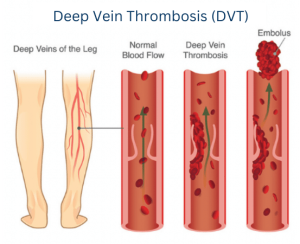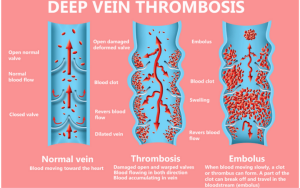What Is Deep Vein Thrombosis and What Causes It?
Deep vein thrombosis (DVT) is a serious condition that occurs when a blood clot forms in a deep vein, typically in the leg. These blood clots can partially or completely block blood flow, leading to swelling, pain, and a potentially life-threatening condition called a pulmonary embolism. While DVT most commonly affects the legs, it can also develop in the arms or pelvis.
Vein health affects the risk of developing blood clots. Understanding the causes, signs, and symptoms of DVT is important so you can protect yourself and know when to seek medical assistance.
SCHEDULE A CONSULTATION ONLINE
Complications of DVT
Two major problems can happen after a blood clot forms in your leg: post-thrombotic syndrome and pulmonary embolism.¹
- Post-thrombotic syndrome: When a blood clot obstructs blood flow, blood pressure before the clot can go up dramatically, causing materials to leak from out of the veins, causing inflammation and skin issues.²
- Pulmonary embolism: This occurs when a piece of a blood clot breaks away and travels to your lungs. This blood clot is called an embolism. It can obstruct blood flow and prevent the body from absorbing oxygen, which is dangerous and requires immediate treatment.
Deep Vein Thrombosis Symptoms
Deep vein thrombosis symptoms can cause excessive pain and impact mobility. Proper diagnosis is important because symptoms of a blood clot in the leg can resemble those of varicose veins. However, symptoms of deep vein thrombosis commonly occur on only one side of the body, typically in one leg or arm.
Understanding what Deep Vein Thrombosis (DVT) feels like can help you be proactive. Some common symptoms of DVT in the legs include:
- Leg swelling on one side
- Warmth in the affected area
- Skin redness
- Pain, tenderness, or cramping in the lower extremities
DVT doesn’t always cause obvious symptoms. Many individuals don’t notice they have DVT until an embolism detaches from the blood clot and travels to the lungs, causing a pulmonary embolism. Symptoms of a pulmonary embolism (PE) include:
- Sudden shortness of breath
- Chest pain that worsens when you take a deep breath
- Dizziness
- Rapid breathing
- Rapid heart rate
DVT can be a serious condition. While it doesn’t always cause obvious symptoms, it’s important to know the signs. If you suspect you may have DVT, such as swelling, pain, or redness in your leg, it’s crucial to seek medical attention promptly.
Early diagnosis and treatment can help prevent complications like pulmonary embolism. Doctors typically treat DVT with blood-thinning medications. In some cases, surgery may be necessary. It’s important to note that DVT can cause long-term effects and may recur.
TALK TO A VEIN SPECIALIST TODAY
Deep Vein Thrombosis Risk Factors
Your body naturally forms blood clots to help heal cuts and scrapes. However, sometimes clots can develop inside the body where they shouldn’t.
You might wonder who is at risk of getting DVT, and the reality is that anyone can develop this condition. Blood clots, including DVT, happen in 900,000 people in the US each year, resulting in 60,000-100,000 deaths.³
Many factors can lead to DVT. If you’re worried about developing DVT symptoms, it’s recommended that you schedule with an experienced vein doctor. They can help identify your individual risks, recommend beneficial lifestyle changes, and perform treatments to improve blood flow.
Some DVT risk factors include:¹,4
- A recent accident or surgery: DVT can develop in veins damaged by surgery or injury, especially when lengthy bed rest is required.
- Personal or family history: If you, a parent, or a sibling has ever been diagnosed with DVT or another blood-clotting disorder, you are considered at increased risk for venous issues.
- Prolonged sitting: Long periods of sitting, such as during air or car travel, can impact circulation and cause DVT in the lower legs.
- Smoking: Smoking can damage your veins, impact circulation, and lead to dangerous blood clots.
- Varicose veins: Individuals with enlarged, visible leg veins are at increased risk for developing deep vein thrombosis.
- Cancer: Some types of cancer, including breast, ovarian, pancreatic, bowel, and lung, along with chemotherapy treatment, can make you more likely to develop DVT.
- Obesity: A high body mass index (BMI) can strain your veins, impacting blood flow and increasing the risk for deep vein thrombosis.
- Pregnancy: Women who are pregnant or have recently given birth are at increased risk for DVT due to the expanding uterus placing pressure on surrounding veins, increased blood flow, and damaged vessels after childbirth.
- Aging: Although anyone can develop DVT, your risk increases beyond the age of 40.
- Increased estrogen: High levels of estrogen caused by birth control pills, hormone replacement therapy, or pregnancy can increase your risk of a clot.
Find A Vein Specialist Near You
Diagnosing Deep Vein Thrombosis and Pulmonary Embolism
Symptoms of DVT and pulmonary embolism can often overlap with other conditions and should be diagnosed by a medical professional.
Conditions that might mimic DVT:
- Cellulitis: A bacterial infection of the skin.
- Muscle strain or injury: This can cause pain and swelling similar to DVT.
- Varicose veins: Enlarged veins can cause discomfort but are generally not as serious as DVT.
Conditions that might mimic pulmonary embolism:
- Pneumonia: Infection of the lungs can cause shortness of breath and chest pain.
- Heart attack: Can present with similar symptoms, including chest pain and shortness of breath.
- Anxiety or panic attacks: These can cause rapid heart rate, shortness of breath, and chest discomfort.
Doctors can use one of several medical imaging methods to visualize blood flow, using ultrasound or X-rays with an injected chemical for contrast. Blood tests can also identify signs that a clot has formed.4
Deep vein thrombosis is a type of blood clot that forms in the deep vein system. When blood clots occur in other types of veins, the condition will have another name and present differently. For example, the term renal vein thrombosis is used for blood clots in the veins draining the kidneys.
SIGN UP FOR OUR NEWSLETTER TO LEARN MORE ABOUT PROTECTING YOUR VEINS
Preventing Deep Vein Thrombosis
DVT is preventable. While DVT is serious, steps can be taken to reduce the risk of clots forming and avoid the possible long-term effects of deep vein thrombosis:
- Move more frequently: Since blood clots often form while traveling or in those who stand or sit for long periods, moving around at least every two hours can help reduce your risk.
- Exercise regularly: Along with avoiding prolonged sitting and standing, it is important to exercise regularly. Most people should aim for at least 30 minutes a day, five days a week. Ask your doctor before getting started.
- Wear loose-fitting clothing: Tight-fitting clothing can put pressure on your veins, impacting circulation to the legs. Consider switching to loose-fitting clothing, especially when traveling or sitting for prolonged periods.
- Maintain a healthy weight: Losing extra weight can alleviate pressure on your veins, lowering your risk for DVT.
- Quit smoking: Smoking and other tobacco products can cause damage to your blood vessels. If you need help, ask your doctor about smoking cessation programs.
- Wear prescribed compression stockings: Medical-grade compression stockings can alleviate DVT symptoms, boost circulation, and reduce your risk of developing additional venous issues.
- Review your medications: Certain medications may increase your risk for DVT. Discuss the pros and cons of your medications with your doctor.
- Treat underlying vein disease: If you have vein disease, minimally invasive vein treatment may help reduce your risk of deep vein thrombosis.
Improve Your Vein Health at USA Vein Clinics
To prevent deep vein thrombosis, we encourage you to take control of your vein health and treat any underlying vein disease. Vein disease is a DVT risk factor.5 If you have varicose veins, spider veins, or other common symptoms of vein disease, consider scheduling an appointment with a vein specialist to discuss treatment plans and prevention tips.
At USA Vein Clinics, our vein specialists will examine your veins for signs of damage. We offer comprehensive vein health screenings using ultrasound mapping. After your exam, we’ll create a personalized treatment plan to help restore your vein health and reduce your risk of deep vein thrombosis. If appropriate, our doctors can perform non-surgical procedures that close damaged veins, allowing your body to reroute blood through healthy veins and improve circulation.
References
- Kevin McLendon, Amandeep Goyal, and Maximos Attia, “Deep venous thrombosis risk factors,” in StatPearls [Internet] (Treasure Island, FL: StatPearls Publishing, 2017).
- Jeffrey J Farrell, Christopher Sutter, Sidhartha Tavri, and Indravadan Patel, “Incidence and interventions for post-thrombotic syndrome,” Cardiovascular Diagnosis and Therapy 6 no. 6 (2016): 623-631.
- “Data and statistics on venous thromboembolism,” US Centers for Disease Control and Prevention, last modified May 15, 2024.
- “Testing and diagnosis for venous thromboembolism,” US Centers for Disease Control and Prevention, last modified May 15, 2024.
- Maxim E Shaydakov, Anthony J Comerota, and Fedor Lurie, “Primary venous insufficiency increases risk of deep vein thrombosis,” Journal of Vascular Surgery: Venous and Lymphatic Disorders 4 no. 2 (2016): 161-166.


